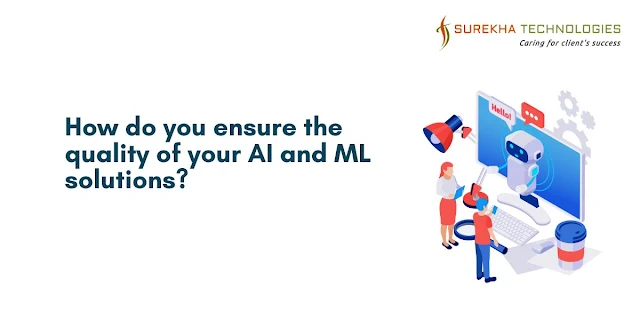Ensuring the quality of AI and ML development solutions is a critical aspect of delivering impactful and reliable outcomes for businesses. Artificial Intelligence (AI) and Machine Learning (ML) have revolutionized industries, offering transformative potential across various domains, from healthcare and finance to manufacturing and customer service. However, the success of these technologies heavily depends on the quality and accuracy of the implemented solutions. This article explores the key practices and methodologies used to ensure the quality of AI and ML development solutions.
Comprehensive Data Quality Management
Data is the backbone of any AI and ML development solution. Ensuring high-quality data is paramount for achieving accurate and reliable models. Data quality management involves:
Data Collection and Cleaning: Sourcing diverse and relevant datasets, followed by eliminating duplicates, errors, and inconsistencies.
Data Annotation and Labeling: Accurately labeling data to provide meaningful insights for training ML models.
Bias Detection and Mitigation: Identifying and addressing biases in datasets to ensure fairness and inclusivity in AI and ML development solutions.
Data Augmentation: Enhancing datasets with synthetic data to improve model generalization without compromising on quality.
Rigorous Model Development and Evaluation
Creating robust AI and ML models involves adhering to industry best practices and employing a systematic approach to development and evaluation. Key steps include:
Defining Clear Objectives: Establishing well-defined goals and success metrics to align model performance with business requirements.
Model Selection: Evaluating various algorithms to identify the most suitable ones based on problem complexity and dataset characteristics.
Hyperparameter Tuning: Optimizing hyperparameters to enhance model performance while avoiding overfitting or underfitting.
Cross-Validation: Using techniques like k-fold cross-validation to evaluate the model’s performance on multiple data subsets, ensuring reliability and robustness.
Continuous Monitoring: Regularly assessing model performance in real-world scenarios to detect drifts and maintain accuracy over time.
Implementation of Robust Testing Frameworks
Testing is an integral part of ensuring the quality of AI and ML development solutions. Various testing methodologies help identify potential flaws and optimize the system’s performance:
Unit Testing: Verifying individual components, such as data preprocessing scripts or feature engineering modules, to ensure correctness.
Integration Testing: Testing how different components interact within the AI or ML pipeline to ensure seamless functionality.
Stress Testing: Evaluating the system’s performance under extreme conditions, such as high data loads or complex queries.
Edge Case Testing: Identifying and addressing potential issues in rare or unexpected scenarios to prevent system failures.
Incorporating Explainability and Transparency
AI and ML solutions must be interpretable and transparent to build trust among stakeholders. Explainability ensures that the decision-making process of AI models is understandable and justifiable. Techniques to enhance explainability include:
Feature Importance Analysis: Highlighting which features influence the model’s predictions the most.
Model-Agnostic Methods: Using tools like SHAP (SHapley Additive exPlanations) or LIME (Local Interpretable Model-agnostic Explanations) to interpret complex models.
Visualization: Employing graphs and charts to present model insights in an accessible and comprehensible format.
Documentation: Provide detailed documentation of the model’s development process, assumptions, and limitations to ensure clarity.
Adherence to Ethical Guidelines
Ethical considerations play a pivotal role in the quality assurance of AI and ML development solutions. Organizations must align their solutions with ethical principles to ensure accountability and fairness:
Data Privacy: Safeguarding sensitive user information and complying with regulations like GDPR or CCPA.
Algorithmic Fairness: Preventing discriminatory outcomes by implementing bias detection and fairness-enhancing techniques.
Human Oversight: Incorporating mechanisms for human intervention to review and validate critical decisions made by AI systems.
Leveraging Automation Tools
Automation can significantly enhance the efficiency and accuracy of quality assurance processes in AI and ML development solutions. Tools and platforms for:
Automated Data Cleaning: Streamlining the data preprocessing stage.
Model Monitoring: Continuously tracking performance metrics with platforms like TensorBoard or MLflow.
CI/CD Pipelines: Implementing Continuous Integration and Continuous Deployment for seamless updates and maintenance.
Collaboration and Cross-Functional Teams
Ensuring the quality of AI and ML solutions requires collaboration among data scientists, engineers, domain experts, and quality assurance professionals. Cross-functional teams help:
Integrate Diverse Expertise: Combining technical knowledge with domain-specific insights.
Streamline Communication: Reducing gaps between stakeholders to align expectations and outcomes.
Promote Continuous Learning: Encouraging innovation and improvement through shared knowledge and best practices.
Final Thoughts
Delivering high-quality AI and ML development solutions involves a multi-faceted approach encompassing data quality, robust testing, transparency, ethical practices, and collaborative efforts. By adhering to these principles, businesses can build reliable and impactful AI systems that drive growth and innovation. Investing in quality assurance not only enhances performance but also establishes trust among stakeholders, ensuring long-term success in an increasingly competitive landscape.

Comments
Post a Comment